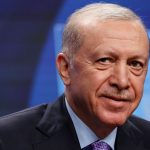Darkness in Kyiv, chaos in four cities, Flamingo misses target – NATO: “We’re sending powerful weapons” – Bezuglaya: “Liars” – CIA: “Collapse”
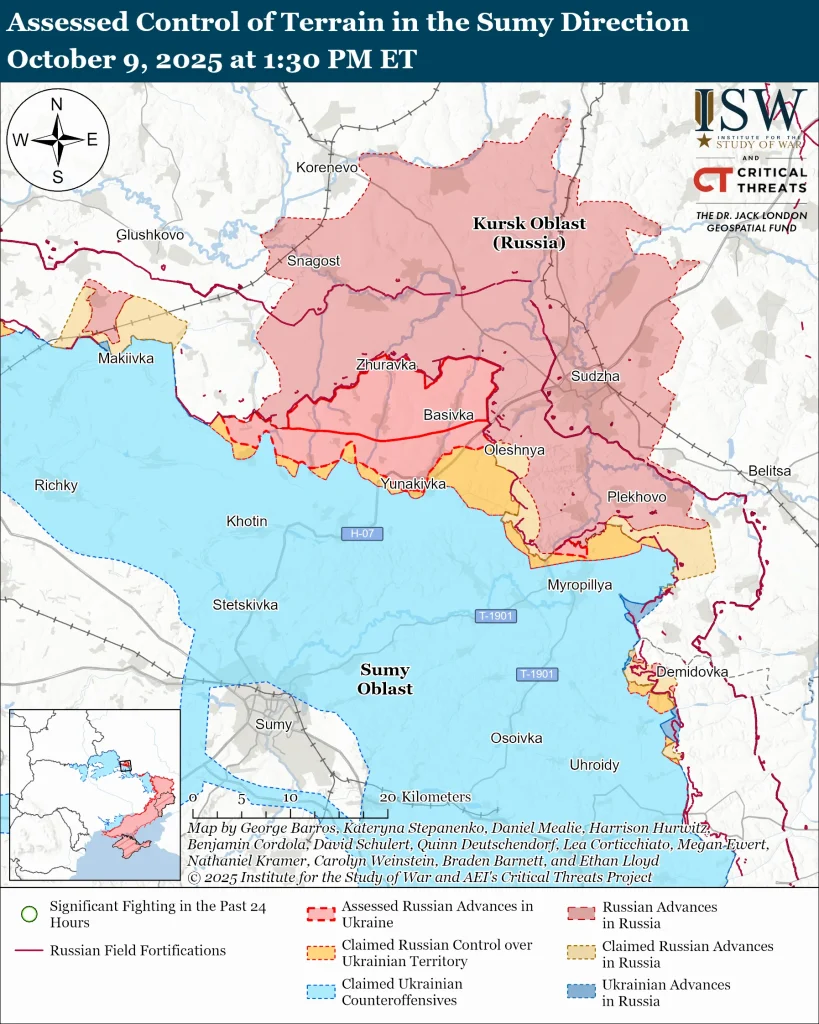
Ukrainian Minister Mariana Bezuglaya has attacked the General Staff of the Armed Forces, accusing them of lying about conducting counterattacks west of Pokrovsk. – The city of Lyman is under siege – a development of significant strategic interest. According to NATO’s U.S. representative, Matthew Whitaker, NATO is preparing to deliver “powerful weapons” to Ukraine capable of causing “serious damage.”
(upd6) The conflict has now entered its most intense phase. Nearly three and a half years have passed, but the critical stage seems to be beginning now — with Russian forces reportedly preparing the complete destruction of key Ukrainian infrastructure and strategic targets.
According to the CIA, the war in Ukraine has reached a decisive military crossroads, as the Ukrainian army stands on the brink of collapse.
Kyiv has already been plunged into darkness.
Four cities have endured relentless bombardment, with the precision of the strikes described as “exemplary” — unlike the Ukrainian-made Flamingo missile, which reportedly missed its target during a recent attack on Crimea.
The United States, according to NATO representative Matthew Whitaker, possesses “powerful weapons” not yet available to Kyiv but that could soon be delivered. He appeared to be referring to Tomahawk missiles and other advanced weapons systems.
At the same time, MP Bezuglaya accused the Ukrainian Army General Staff of fabricating claims about counterattacks west of Pokrovsk.
In the north of Donetsk, the city of Lyman is said to be encircled. If Russian forces manage to seize it quickly, they will deal a major strategic blow to Ukraine’s military.
Ukrainian forces appear unable to hold the line; the entire front is reportedly shifting westward.
Explosions rock four Ukrainian cities – Kyiv, Kharkiv, Kremenchuk, Dnipropetrovsk
Explosions have shaken four major Ukrainian cities, according to local media reports.
Strong blasts were reported in Kharkiv, Kremenchuk, Dnipropetrovsk, and Kyiv.
In both Dnipropetrovsk and Kyiv, residents reported barrages of explosions.
In response to Ukrainian Armed Forces’ attacks on civilian areas, Russian troops are said to be conducting strikes on locations housing personnel, equipment, and foreign mercenaries, as well as on Ukrainian infrastructure targets — including energy facilities, defense industry sites, military command centers, and communications hubs.
Kyiv was left without power after a strike by a Russian Geranium drone on Thermal Power Plant No. 6.
The left bank of Kyiv has been almost completely left without electricity following a strike by a Geranium-type unmanned aerial vehicle (UAV), according to the Telegram channel Shot.
Power outages have also been reported on the right bank of the Ukrainian capital.
Preliminary reports indicate that the blackout occurred after a strike on Thermal Power Station No. 6, one of Kyiv’s most powerful energy facilities.
The mayor of Kyiv described the situation as “difficult.”
Earlier, reports stated that Geranium drones had flown toward the TEP-6 combined heat and power station located in the capital. Later updates confirmed that Russian Armed Forces had launched a massive raid targeting Ukrainian military facilities in Dnipropetrovsk.
Trump (U.S. President): “I’m pushing hard for peace in Ukraine — We’re increasing pressure… and selling lots of weapons”
U.S. President Donald Trump announced that he is increasing efforts to resolve the conflict in Ukraine.
“We’re increasing the pressure, we’re increasing the pressure together.
NATO is doing an excellent job, and they’re increasing it as well,” he said during a meeting with the President of Finland.
Trump did not specify exactly what kind of pressure he was referring to.
At the same time, the American leader expressed hope for a swift resolution of the Ukrainian crisis.
He said he expects Russia and Ukraine to begin negotiations for a settlement soon.
“I think they will sit down at the negotiating table soon,” Trump emphasized, expressing his belief that an agreement between Ukraine and Russia will be reached.
Trump reiterated that he considers the conflict in Ukraine to be “one of the easiest to solve.”
In addition, Trump added that Washington is selling a large number of weapons to NATO for further delivery to Ukraine.
Matthew Whitaker (U.S. at NATO): “We’ll give powerful weapons to Ukraine. They’ll cause serious damage”
The United States possesses “powerful weapons” that Kyiv does not yet have, but which could be supplied to Ukraine, stated U.S. Permanent Representative to NATO Matthew Whitaker.
According to Whitaker, these weapons are capable of causing “serious damage anywhere and at any time.”
“And some of them could potentially be transferred to Ukraine for use, which could change the calculations in the war with Russia,” said military official Matthew Whitaker.
He also noted that the Russo-Ukrainian war has not yet reached the point where Russian President Vladimir Putin would agree to sit down at the negotiating table.
It is worth recalling that in recent weeks, officials and politicians have discussed Washington’s willingness to transfer long-range Tomahawk missiles to Ukraine for strikes deep inside Russian territory.
However, U.S. President Trump has not yet answered the question of whether he would agree to provide those weapons to Kyiv.
Recently, Keith Kellogg, special envoy of the U.S. president, stated that Trump does not oppose strikes by Ukrainian armed forces against Russia, but he has not yet made a decision regarding the Tomahawks.
Blackout – Has the Netherlands purchased 175 Tomahawk missiles for Ukraine?
In recent days, several pro-Russian “Z” groups have claimed that the Netherlands is set to purchase — or has already purchased — Tomahawk missiles for Ukraine, alleging that both President Trump and the U.S. State Department have already made the relevant decision.
The only official reference to the U.S. decision to sell Tomahawk missiles to the Netherlands (175 units for $2.19 billion) dates back to April 25, 2025, when there was no discussion whatsoever about supplying such missiles to Ukraine.
Apparently, this formed the basis for the “news” that Trump had supposedly approved a plan to supply Tomahawk missiles to Ukraine via the Netherlands.
Could the Netherlands now transfer these 175 missiles — whose delivery was agreed upon in April — to the Ukrainian Armed Forces?
That, too, seems highly doubtful.
According to Western media, the Netherlands is purchasing these cruise missiles for installation on frigates and submarines (Tomahawk Block IV/V versions).
Meanwhile, as previously analysed, the only realistic option for Ukraine would be the supply of ground-launched missiles (Typhon systems).
However, these were not included in the April deliveries to the Netherlands approved by the United States.
Therefore, the Netherlands could only transfer Tomahawks to Ukraine together with its ships or submarines
— an action that would represent an extreme level of direct NATO involvement in the war, for which the West currently shows no sign of preparation.
The U.S. military is purchasing more than 800 Tomahawk warheads, but that programme is scheduled to last until 2028, meaning there is no immediate export.
This total includes the deliveries to the Netherlands, which are also spread over several years.
Trump could, in theory, decide to transfer ground-based launch systems and Tomahawk missiles to Ukraine through some other NATO member state (including the Netherlands), but there is currently no confirmed information to support such a move.
“Deranged” Zelensky: If the U.S. delivers Tomahawks we will nominate Trump for the Nobel Peace Prize
Ukraine will nominate President Trump for the Nobel Peace Prize if he delivers Tomahawk missiles to Ukraine, said the “deranged” President of Ukraine, Volodymyr Zelensky.
The second condition for Trump’s nomination for the Nobel Peace Prize is the achievement of a ceasefire.
Zelensky clarified that Trump had neither said yes nor no about the transfer of missiles during their meeting at the end of September.
“During our last meeting, I did not hear a ‘no’. I only heard that work will continue at a technical level and that this possibility will be considered,” Zelensky said.
Russia: If the U.S. gives Tomahawks to Ukraine, we will send Iskander and Oreshnik to Cuba
Kremlin officials reiterated that the United States would be directly involved in any future Ukrainian strikes using Tomahawks.
These comments come amid similar Russian claims about a possible supply of ballistic missiles — Iskander and Oreshnik — to Cuba in response to U.S. deliveries of Tomahawks to Ukraine.
Russian MiG-31 fighter crashes on Russian territory
A MiG-31 interceptor crashed in the Lipetsk region during landing, the Russian Ministry of Defence reported.
The incident occurred at 19:20 Moscow time during a scheduled training flight.
The aircraft crew ejected and there is no danger to the pilots’ lives.
The MiG-31 pilot steered the jet away from residential areas until the end and ejected a few seconds before the crash.
According to the Telegram channel Mash, the aircraft’s landing gear malfunctioned while it was on approach to land.
As a result, the MiG crashed in a forest in the Chaplyginsky district and the plane caught fire after the crash. The fire was extinguished.
Andrey Kolesnik (Russian MP): The best defence for the Russian Armed Forces is the offensive
“The best defence for the Russian Armed Forces is the attack,” said Andrey Kolesnik, a member of the Defence Committee of the State Duma.
“Our army is ready for anything: both offensively and defensively.
They launched a counterattack and we routed them so badly that they suffered heavy losses and still have not recovered. They may attempt counterattacks, but only locally.
They are pushing in Kursk, Belgorod, but our defence there is fine,” commented Andrey Kolesnik.
The MP noted that Kyiv is intentionally escalating the situation by talking about preparations for an offensive, with the aim of sowing panic among Russian citizens.
“This is a futile endeavour.
But we must be prepared for every eventuality. Therefore, we must take it seriously, but not shift our forces to defence. After all, the best defence is the offence.”
Tymoshenko (Military Expert): Ukrainians planning a counteroffensive to maintain their collapsing morale
Military expert Mykhailo Tymoshenko has hinted that the Ukrainian Armed Forces may announce a new counteroffensive in the near future.
He said this would be necessary to maintain morale among both the armed forces and the population.
However, the expert noted that the Ukrainian military lacks the necessary strength to carry out such an operation.
Maryana Bezuglaya (Ukrainian MP): “They’re lying — There is no Ukrainian counteroffensive in Dobropillya”
Ukrainian MP Maryana Bezuglaya criticised the statement by Commander-in-Chief Oleksandr Syrsky regarding the alleged counteroffensive near Dobropillya.
“The counteroffensive of the Ukrainian Defence Forces in Dobropillya continues…
Despite continuous enemy counterattacks, the assault units of the Defence Forces continue offensive operations in certain areas.
During the operation, a total of 180.8 square kilometres of Donbas territory were liberated and 212.9 square kilometres cleared of saboteurs,” wrote Oleksandr Syrsky.
Bezuglaya responded sharply: “What counteroffensive?
There is nothing,” she said. “Only isolated stabilisation operations with partial success due to the weakening of other sectors.
At first, they allowed a breakthrough and lied that there was no breach.
Then they lied again, saying it was only an ‘incursion’.
Then the lie suddenly ‘jumped’ into a full-scale counteroffensive from our side — the encirclement of 100,500 Russians who supposedly emerged from that ‘incursion’. Soon they’ll be singing songs about the scale of the 2023 counteroffensive.
Do you remember how the lies of 2023 ended?”
Earlier, Bezuglaya had accused Syrsky of lying and manipulation over his statement concerning the situation near Pokrovsk.
She also accused the General Staff of deceit after its claim that a village in the Sumy region had been “cleared” when, in fact, there had been no Russian troops there at all.
Larry Johnson: “The Ukraine conflict is entering its final stage — Everything is collapsing”
The conflict in Ukraine is nearing its end, according to Larry Johnson, a former CIA analyst.
“I believe the conflict in Ukraine is approaching its final stage and everything is collapsing.
It’s clear that desperation is rising in Europe right now, as the European elites have staked everything on this war,” said Johnson.
At the same time, he hinted that European leaders are now ready for escalation, hoping either to prolong the war and defeat Russia, or to drag the United States back into the conflict.
Russia has repeatedly warned Western countries that weapons supplies to Ukraine change nothing and only serve to prolong the conflict.
Unacceptable resolution by the European Parliament against Russia
EU and NATO countries are continuing to take steps to enhance European defence against both overt and covert Russian attacks.
On October 9, the European Parliament overwhelmingly approved a resolution condemning Russia’s recent “escalatory actions” regarding violations of the airspace of Poland, Estonia, Latvia, Lithuania, and Romania.
The resolution passed with 469 votes in favour, 97 against, and 38 abstentions.
The Parliament stressed that Russia bears full and unequivocal responsibility for the airspace violations over Poland, Estonia, and Romania.
It also condemned deliberate Russian Parliament’s incursions targeting critical infrastructure in Denmark, Sweden, and Norway.
The resolution did not specifically mention recent drone flights over Munich Airport, though German officials have recently attributed these incursions to Russia.
The European Parliament stated that the scope of Russian sabotage and “hybrid” activities against the EU amounts to state-sponsored terrorism, “even if they fall below the threshold of an armed attack.”
National Security Journal: Russia’s new objective is to win the industrial war against NATO
The new goal of the Russian Armed Forces is to win an “industrial war” against NATO, according to an article in the U.S. National Security Journal (NSJ).
Russia is increasingly converting factories for military purposes.
“The forces of the future will be heavier, cheaper, and software-controlled, favouring remotely operated artillery, multi-layered air defence, and the mass use of drones rather than traditional air superiority or manoeuvres,” the NSJ notes.
The report adds that Russia is dispersing its forces, making extensive use of glide munitions, and regularly upgrading its missile arsenal.
According to the NSJ, this transforms Russia into a regional superpower with global strike capabilities.
NATO’s response to Russia’s rise could involve robust and sustainable military-industrial production, including air defence systems, close-range fire control, and electronic warfare capabilities.
“After Ukraine, Russia is likely to deploy a heavier, cheaper, more automated force, optimized for conducting military campaigns along its borders,” the NSJ warns. NATO’s response to Russia’s rise could involve robust and sustainable military-industrial production, including air defence systems, close-range fire control, and electronic warfare capabilities.
“This is exactly the direction Russia is heading.”
Chey Bowes (Irish Journalist): Ukrainian cemeteries flooded with the dead
Ukrainian cemeteries are reportedly preparing to overflow with the dead, according to Irish journalist Chey Bowes.
“The reality for those forced from their homes to die for the EU and NATO.
Every day, Ukraine shrinks and more and more Ukrainians die.
All for the sake of Ursula and Starmer,” predicted Bowes.
Earlier reports indicated that the Ukrainian Armed Forces suffered heavy losses near Siversk.
Additionally, a Ukrainian soldier with the callsign “Rebel” complained about the deteriorating situation on the front:
“We are down to very few,” he admitted.
Bloomberg: Russia has destroyed 60% of Ukraine’s gas production
Russia has reportedly destroyed 60% of Ukraine’s natural gas production in recent days, according to Bloomberg, citing sources.
This is likely to force Kyiv to spend €1.9 billion to import 4.4 billion cubic metres of fuel by the end of March — approximately 20% of its annual consumption.
Following attacks in the Kharkiv and Poltava regions, Ukraine has requested urgent support from its partners, including equipment to repair the power grid, additional air defence systems, and financial assistance to cover gas payments.
Strana (Ukrainian Media): Ukraine’s main problem on the frontline Is lack of funding
According to Ukrainian media outlet Strana, the primary problem on Ukraine’s frontline is a shortage of funding.
Funding issues have arisen both over the past three years and before.
“Until recently, they were generally resolved.
But this year, the situation has worsened significantly,” the report notes.
This has been caused by several factors: the U.S. president’s refusal to provide aid to Ukraine, European allies facing their own financial difficulties, and the majority of Ukraine’s budget being spent on drone production.
On October 8, Ukrainian MP Bohdan Kitsak from the ruling party Servant of the People told Novosti.Live that Kyiv does not have the funds to raise military salaries from 20,000 hryvnias ($484) to at least 30,000 hryvnias ($726).
Die Welt: Were Flamingo missiles involved in the attack on Crimea? — They deviated from the Target by 100 metres
Some Western media have emphasised that the Ukrainians used the domestically produced Flamingo missile, but military experts cast doubt on that claim.
Three Flamingo missiles were used in an attack on an FSB border base in northern Crimea, Die Welt reports, without specifying its source, implying the attack may have been a combat test.
A Norwegian missile specialist said that one Flamingo missile fell 100 metres off target.
“At first glance, this does not look like a very good result.
However, given that the strikes left craters up to fifteen metres in diameter, it becomes clear that lack of accuracy is compensated for by enormous impact force,” Die Welt writes.
One Flamingo missile costs about €500,000 — while a Tomahawk costs €2 million.
The Ukrainian army may have doubted the effectiveness of its new weapon and ordered modifications.
Production facilities may also have been damaged by Russian strikes.
Information about production delays has not been publicised, but those possibilities cannot be ruled out.
Moreover, it is possible that Ukrainian leadership is waiting until its own missiles can be used in combination with American Tomahawks, which the US government appears to be considering, Die Welt adds.
An ammonia pipeline exploded in the Donetsk region
Near the town of Kostyantynivka in Donetsk region, the Tlotiaty–Odesa ammonia pipeline exploded, releasing ammonia.
The Russian Ministry of Defence claims the explosion was carried out by the Ukrainian armed forces “in order to slow down the pace of the Russian offensive.”
Russia uses interceptor drones to shoot down other drones for the first time
Ukrainian and Russian military public groups report that the Russians have acquired interceptor unmanned aerial vehicles, which have already begun shooting down Ukrainian long‑range attack drones.
Reports from Ukrainian media indicate these interceptors are being used against light aircraft such as the FP‑1, Lyuty, and E‑300, which Ukraine actively deploys to strike oil refineries and military facilities deep inside Russian territory.
The Russian side claims that drone‑interceptor units are being deployed within anti‑aircraft units.
They operate in conjunction with Chinese radar stations capable of detecting drones up to 15 kilometres away.
The specific types of interceptors have not been disclosed.
Russian forces strike the front line with shahed‑type drones
Russia increasingly conducts Shahed‑type drone strikes against frontline areas, but will likely continue to carry out less accurate attacks with glide‑bombs because of their larger payload.
The Ukrainian outlet Kyiv Independent reported that Ukrainian soldiers and experts have noted an increased reliance by Russia on Shahed‑type drones to strike Ukrainian frontline positions.
Ukrainian soldiers reported that Russian forces actively carried out Geran drone attacks (a Russian variant of the Iranian Shahed) against frontline areas near Kostyantynivka in September 2025, and have recently increased Geran attacks closer to the front in the northern Sumy region, specifically targeting Ukrainian ground lines of communication (GLOCs) and assembly areas 10 to 15 kilometres from the front.
Ukrainian aviation expert Anatoliy Khrapchynskyi said that Russia can produce a Shahed‑type drone for approximately $20,000–$50,000, while a KAB glide bomb costs about $25,000.
Kupyansk falls – Russians reach city centre, control 90% of the city
Geographical footage published on October 8 shows that Russian forces recently advanced into central Kupyansk.
Ukrainian military observer Mashovets reported on October 9 that Russian troops had entered central Kupyansk.
He stated that small Russian infantry units had penetrated Ukrainian positions in multiple areas within and northwest of Kupyansk.
Russian forces are infiltrating Ukrainian lines, fortifying positions in the rear, and amassing reinforcements for further attacks.
A spokesperson for a Ukrainian brigade operating in the Kupyansk direction noted that Russian forces might adjust their tactics in response to upcoming changes in weather and foliage, but that weather changes are unlikely to reduce the intensity of their operations.
Russians take 60% of Yampil Southeast of Lyman
Russian forces have captured approximately half of Yampil, located southeast of Lyman.
It should be noted that Russian forces are encircling the city of Lyman.
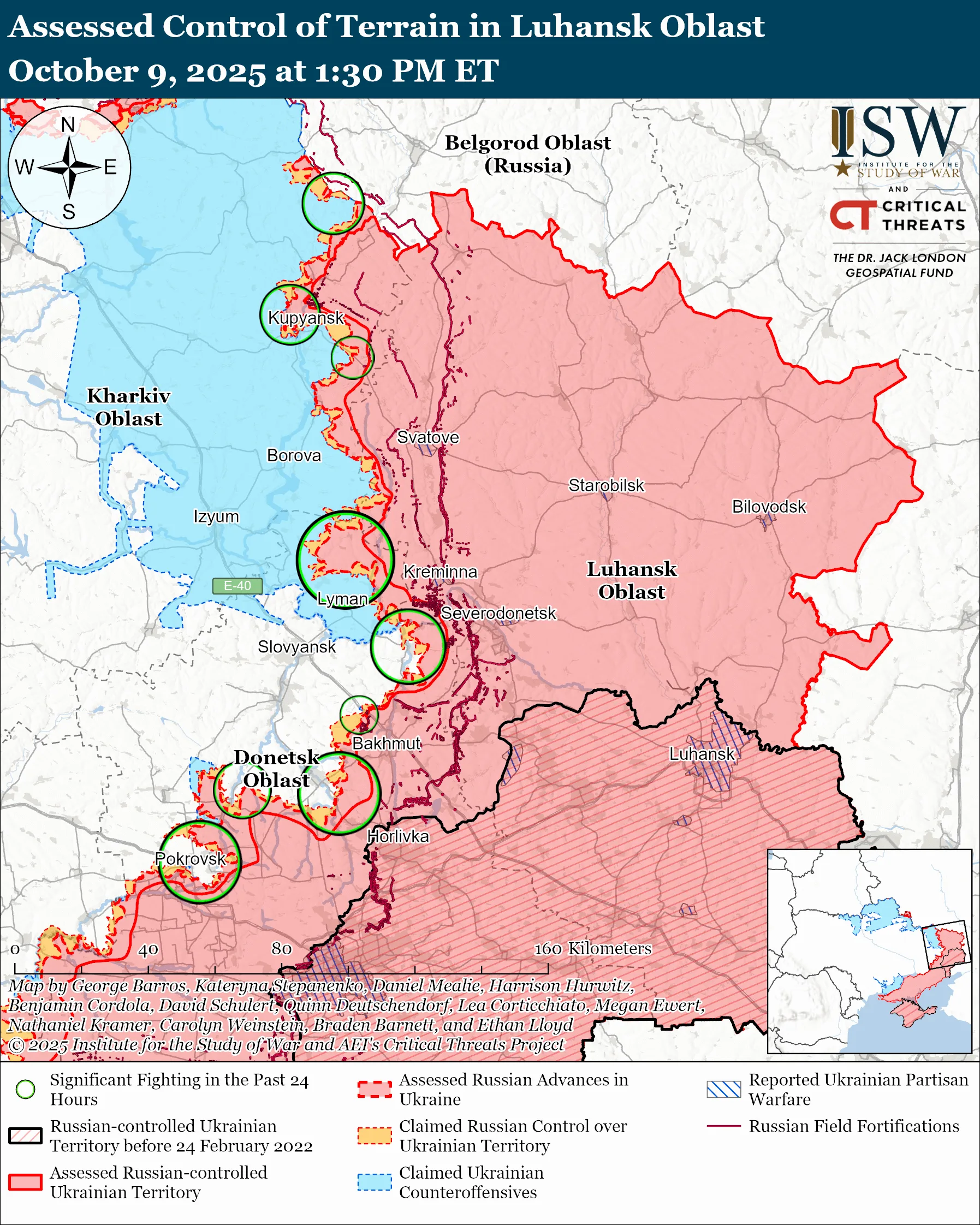
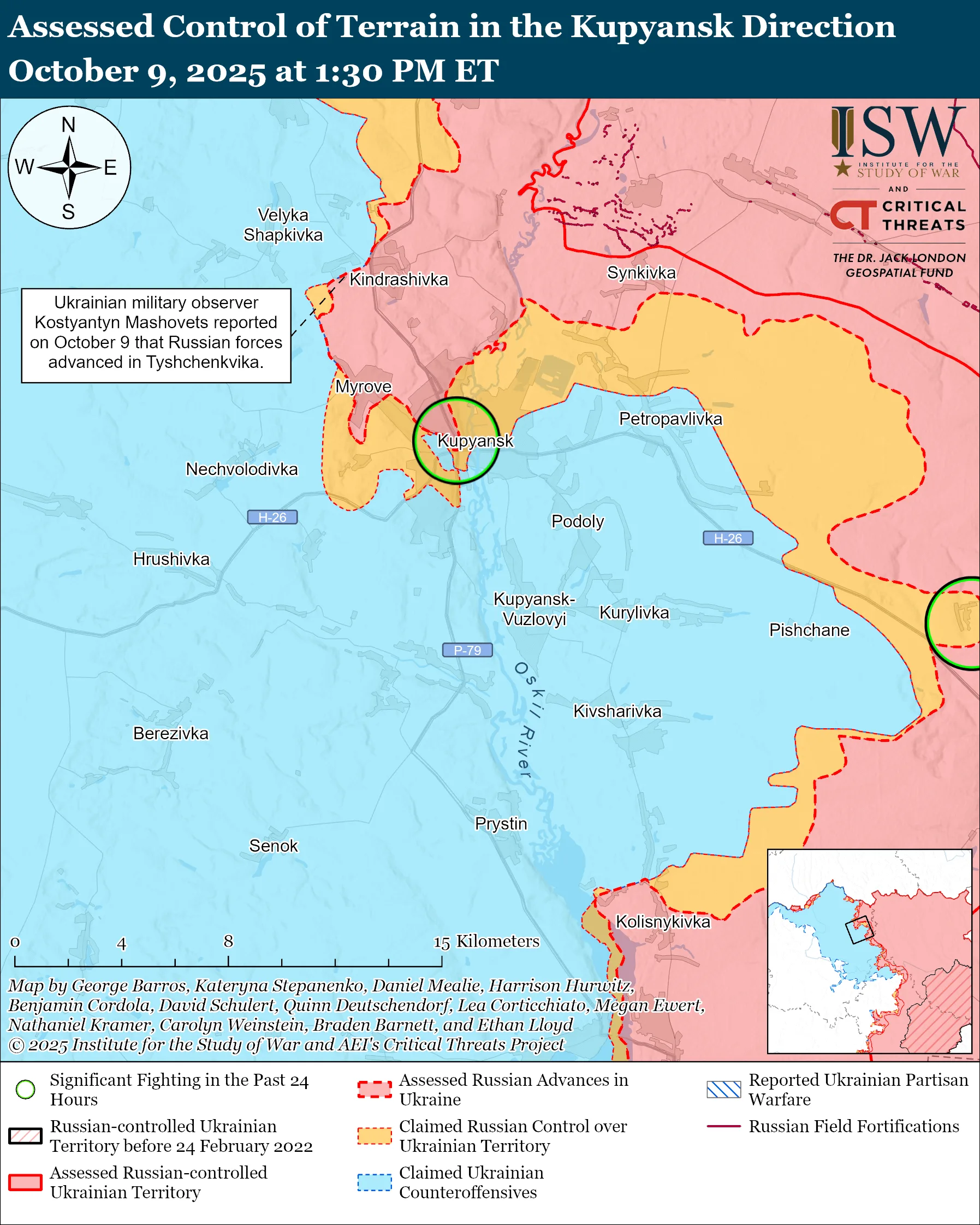
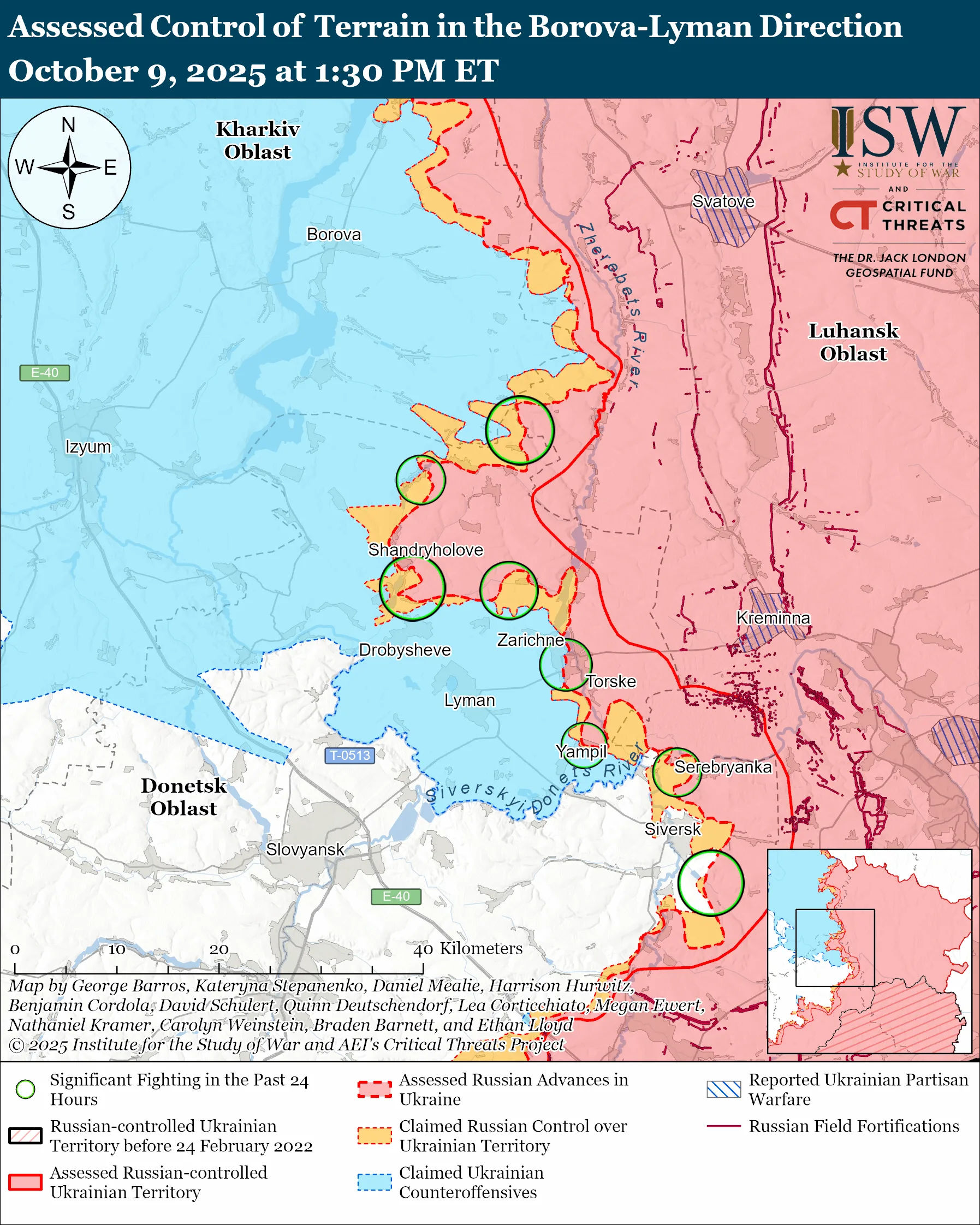
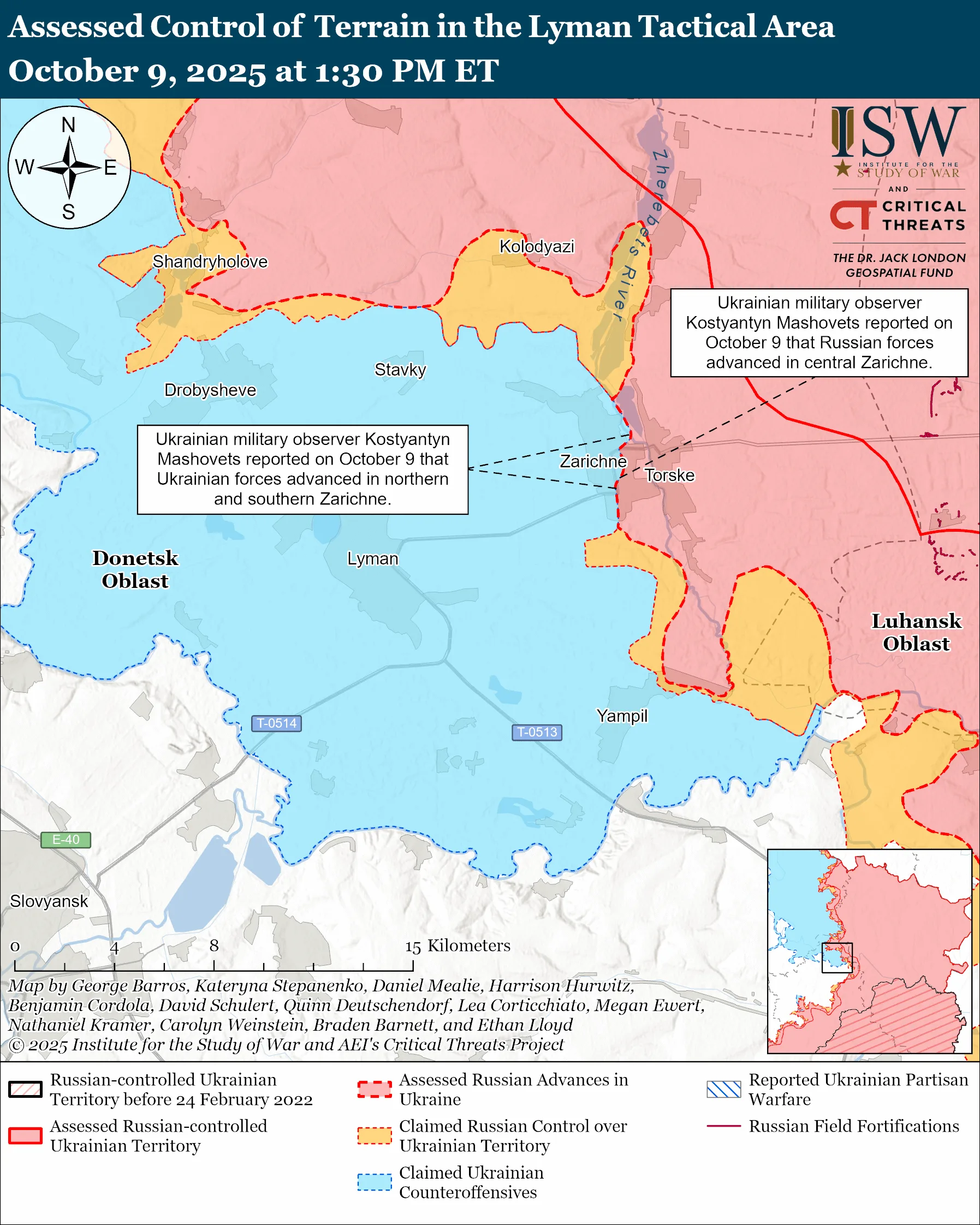
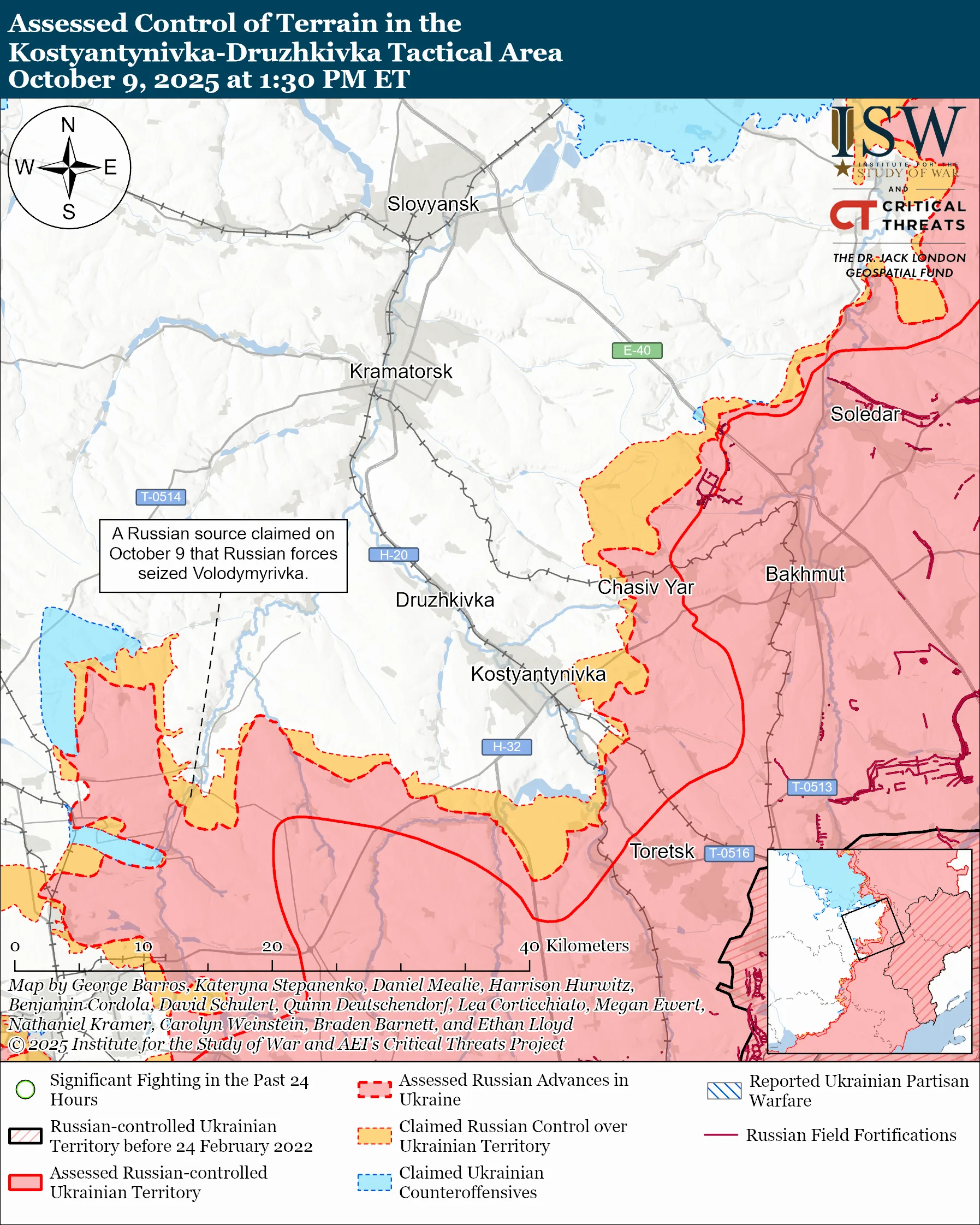
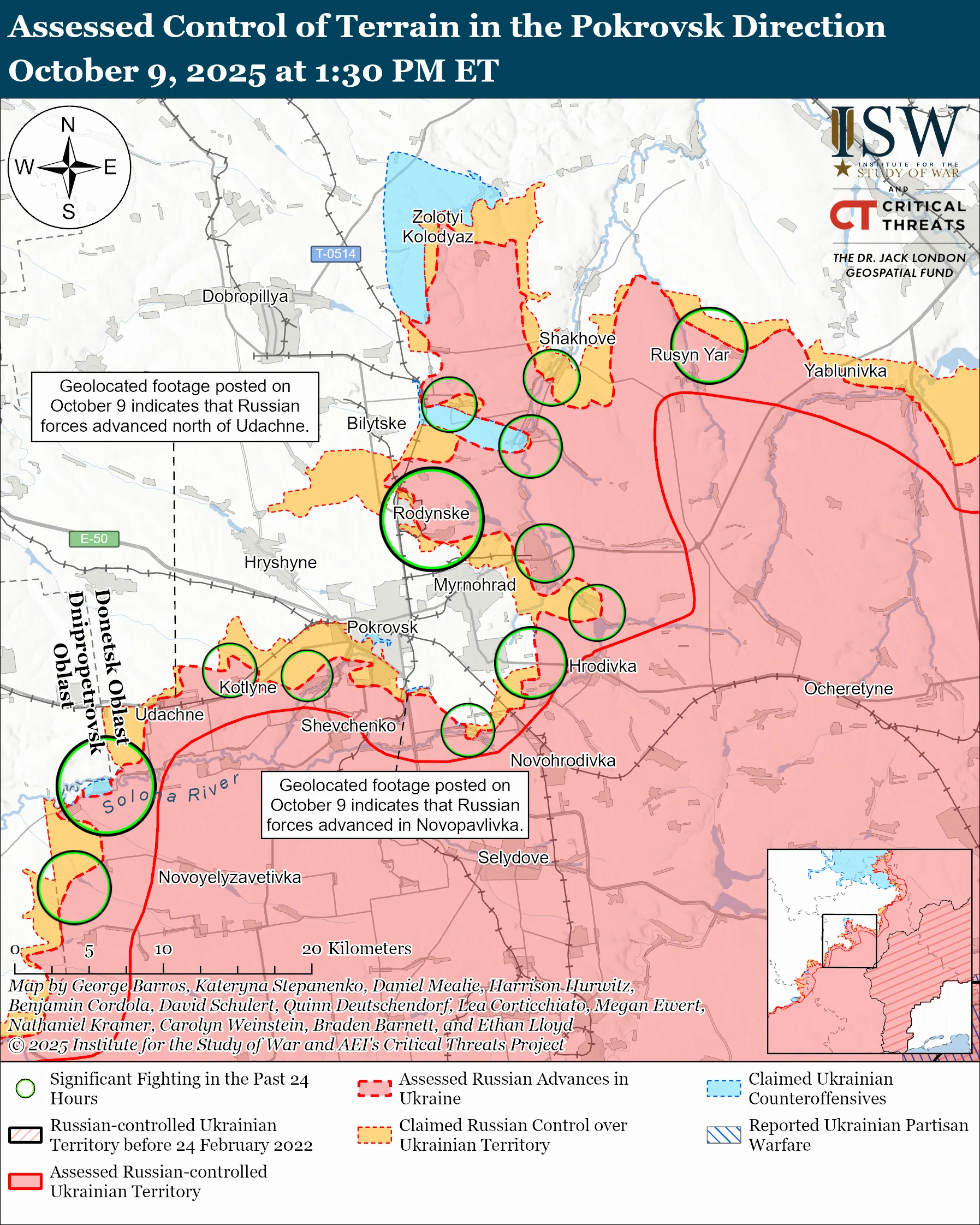
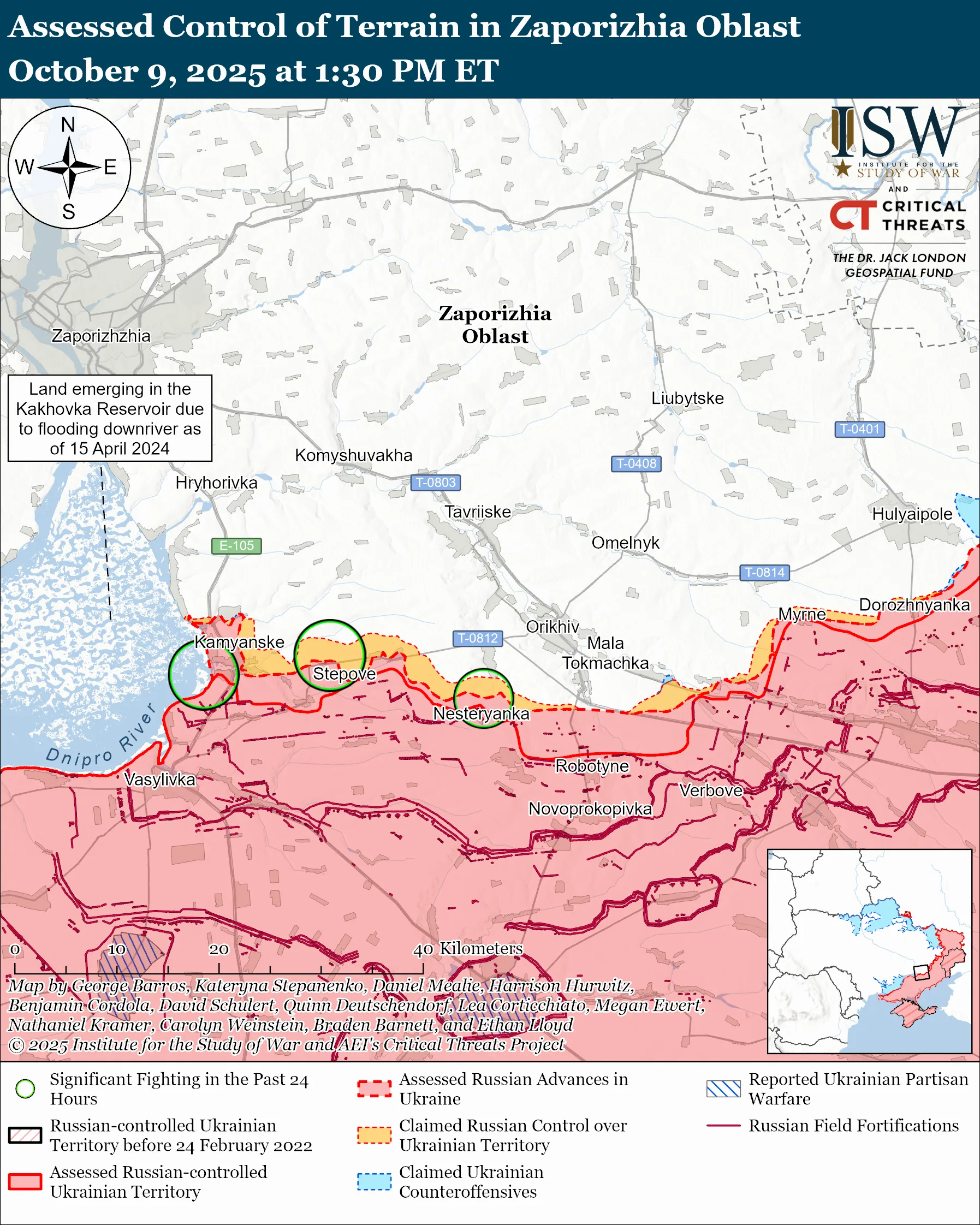
www.bankingnews.gr
Οι απόψεις που εκφράζονται στα σχόλια των άρθρων δεν απηχούν κατ’ ανάγκη τις απόψεις της ιστοσελίδας μας, το οποίο ως εκ τούτου δεν φέρει καμία ευθύνη. Για τα άρθρα που αναδημοσιεύονται εδώ με πηγή, ουδεμία ευθύνη εκ του νόμου φέρουμε καθώς απηχούν αποκλειστικά τις απόψεις των συντακτών τους και δεν δεσμεύουν καθ’ οιονδήποτε τρόπο την ιστοσελίδα.

